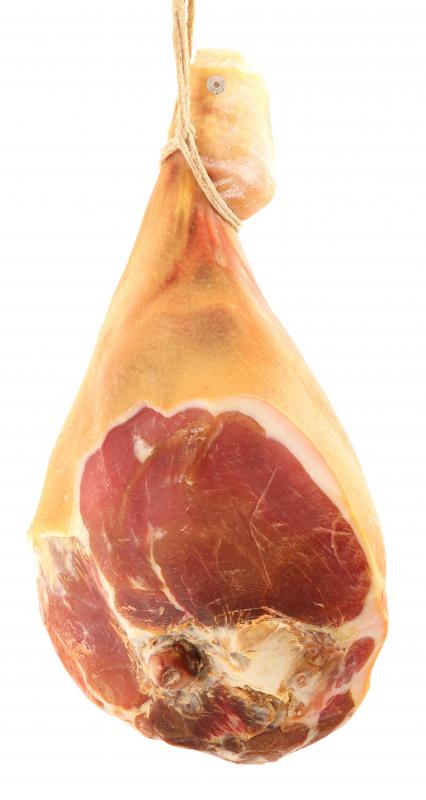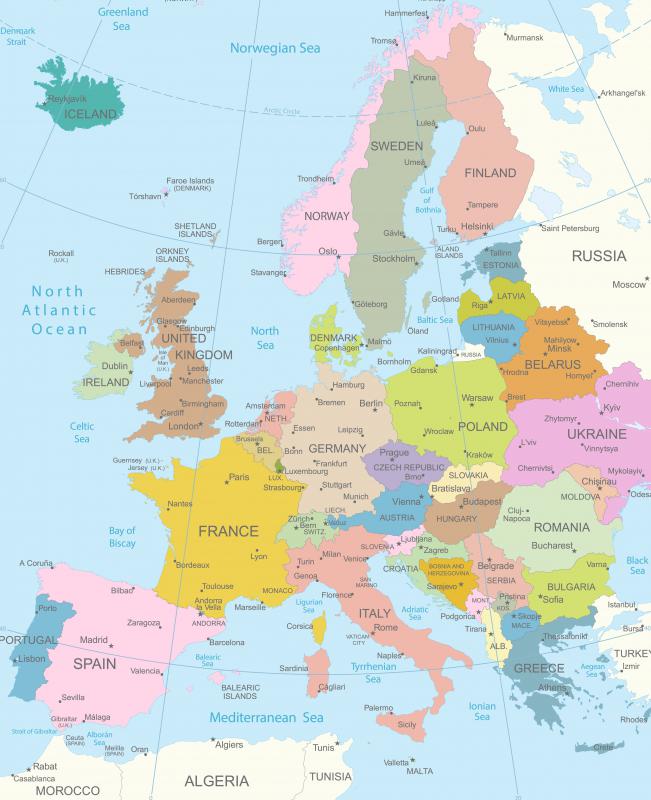At DelightedCooking, we're committed to delivering accurate, trustworthy information. Our expert-authored content is rigorously fact-checked and sourced from credible authorities. Discover how we uphold the highest standards in providing you with reliable knowledge.
What is Parma Ham?
Parma ham is a type of dry-cured pork from the Parma region of Italy. It is one of the most well-known varieties of prosciutto crudo or uncooked ham. Parma ham is used in a wide range of meals, such as salads and pasta dishes, and can be enjoyed on its own as an appetizer or "antipasto." The process of preparing this ham involves careful selection of the meat and months of drying and curing.
Common Uses in Cooking

Chefs often use Parma ham, or Prosciutto di Parma, in many types of Italian cooking. Salads, both vegetable and pasta varieties, benefit from the saltiness and tremendous flavor of the ham. Hot pasta dishes can include ham to add remarkable flavors and texture, and chefs often use it in sandwiches. Many people eat it as an appetizer, often wrapped around a slice of melon.
Nutritional Information

About two slices of Parma ham can contain around 75 calories, which can be a lot for some eaters. Around two-thirds of those calories come from fat, though it is quite low in saturated fats. The intense flavor of the ham, created through drying and aging, makes even a small amount quite effective in a dish. If served with cream sauce, however, the fat content of the entire meal is likely to be much higher.
Selection and Preparation

Parma ham owes much to the unique geography of the Parma region, which ensures constant gentle breezes coming across the hills. Like many specialty foods and beverages in Europe, its production is tightly regulated to ensure a certain level of consistent quality throughout, and it is protected by the Parma Ham Consortium. Only Duroc or Landrance pigs are chosen for this ham, and they are fed on full-cereal diets, often enriched with whey to give them added calcium.

Once prepared in the classic ham leg shape, the skin is wet salted, the flesh itself is dry salted, and the entire leg is hung in a refrigerator for about a week at between 34 and 39 degrees Fahrenheit (1 to 4 degrees Celsius), with humidity of around 80%. At the end of the week, the excess salt is brushed off, and it is put through a round of quality control. Ham that makes it through this process is salted again, and placed in another cold chamber for two weeks, this time at 34 degrees Fahrenheit (1 degree Celsius) with humidity of 60%.
Additional Curing

The Parma ham is then placed in a chamber with humidity of 75% between 34 and 41 degrees Fahrenheit (1 to 5 degrees Celsius) and left there for about eight weeks. After that, it is rinsed with warm water, to get rid of most of the excess salt, dried, and then placed in the actual curing chambers, where it remains for three more months. The curing chambers are not artificially cooled or humidified, and are at the whim of nature to dictate how the ham cures.

During this penultimate curing the Parma ham is also covered in a mixture called suino, which contains salt and pepper, lard, and occasionally a bit of ground up rice. This keeps flies off of the meat, and stops it from drying too quickly. Finally, the ham is moved into a cellar, where it finishes curing in the dark for a year or more, before being tested for final quality, and ultimately branded with a seal of approval.
AS FEATURED ON:
AS FEATURED ON:
















Discussion Comments
Parma ham contains lot of visible fat. How come it is low fat.
How much time does Parma ham take for curing?
Because Parma ham has all of the visible fat removed, it actually contains very few calories. 100 grams of Parma ham contains just 3.5 grams of fat, which is lower than turkey breast. It contains many free amino acids and is easily digested. This meat is great for those on a low-calorie diet who refuse to sacrifice flavor.
Gorgonzola cheese also tastes great with Parma ham. Try it tossed in with some roasted veggies and enjoy!
Parma ham can be an interesting addition to a salad. One of my favorites involves a mixture of fresh strawberries, mozzarella, basil leaves, walnut pieces, and cracked black pepper. This salad is best topped with a kiwi-lime vinaigrette. It is a great summer salad because of the refreshing mix of salty and sweet flavors.
I think parma ham (or since I'm Croatian, we call it pršut) makes for a great appetizer. Almost all our meals start with a cheese and parma ham starter. Usually the cheese is a dry, aged sheep's cheese. So good.
nightlights - I think making parma ham takes months because it needs time to thoroughly dry. And, I think it's hung in the dark because light and sunlight especially would affect the coloring and taste of it. Plus being in the dark it helps
Wow it takes a long time to get Parma Ham! What exactly does the curing time in the dark do? Does it have to be dark to complete the process or is that just a cost saving feature?
Post your comments